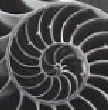 |
Problems for
Intermediate Methods in Theoretical Physics
Edward F. Redish |
Linear spaces of functions
In our work in class so far we have used vector spaces to describe the position
of objects in space, other physical quantities built from position such as velocity
or momentum, and physical quantities that transformed in some way like position
such as force or magnetic field. We have built up larger spaces by describing
the motion of one particle in many dimensions or many particles (so far) in one
dimension. As a result of these two different examples, we have created a mathematical
abstractions -- a linear (vector) space -- that obeys certain properties. Once
we have these properties, we can apply these ideas to other examples, effectively
finding cases in which the analogy to motion of a particle in many dimensions
(or of many particles in one dimension) is so good that we can use the same math.
One example that will turn out to be of great importance, both in wave theory
in elastic media and in quantum physics, is the case of functions. We'll begin
by working out a simple example.
Consider the set of functions consisting of the sum of the two functions sin θ and
cos θ:
f(θ) = a sin θ + b cos θ.
.
where a and b are arbitrary complex numbers. We can associate this function with a vector
Prove that this set of functions forms a linear space according to the
definition of a linear space given in class.
Solution
In
order for a set of objects to be a linear space, you have to be able to define
the sum of the objects and the scalar multiplication with a number (either real
or complex). The usual rule for adding functions -- that is, you add the values
point by point -- and for multiplying a function by a constant work here.
(
f + g)(
x) =
f(
x +
g(
x)
(af)(x) = a (f(x).
The left hand sides of these equations may seem a bit strange. What we mean by "(f + g)(x)" is "the function we associate with the linear space sum of two function f and g" and what we mean by "(af)(x)" is "the function we associate with the scalar multiple of the function g by a constant (scalar) a".
Once we know what we mean by the sum and scalar multiple of a function in our space, it is very straightforward to prove all the required properties.
- The sum of two elements of the space is an element. (f(x) + g(x) is the sum of a sine + a cosine if both f and g have that form.)
- The 0 function works as the identity vector.
- For any function in the space, f(x), the function -f(x) works as an additive inverse.
- For any complex number z and element of our space f(x) = a sin θ + b cos θ, the function (zf)(x) = (za) sin θ + (zb) cos θ
is in our space.
- Multiplication by 1 serves as an identity for scalar multiplication.
- For every complex z ≠ 0, multiplication by 1/z serves as a multiplicative inverse.
- Distribution is inherited (follows directly) from the distribution of addition and multiplication of numbers and functions.
RETURNS
| University of Maryland | Physics Department | Physics 374 Home |
 |
 |
 |
This page prepared by
Edward F. Redish
Department of Physics
University of Maryland
College Park, MD 20742
Phone: (301) 405-6120
Email: redish@umd.edu
Last revision 28. October, 2005.





